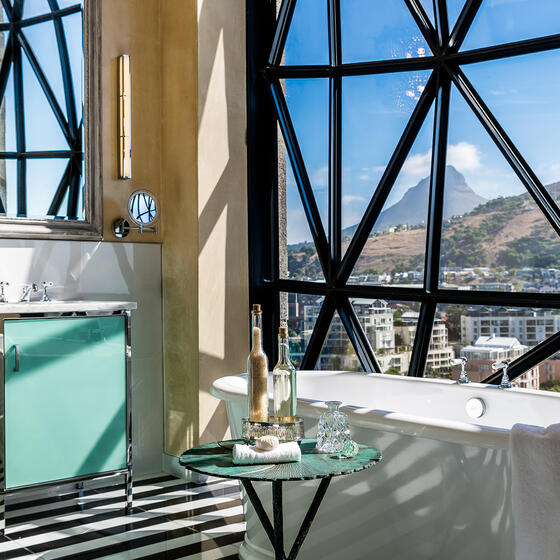This sultry CBD hotel offers an alternative to the classic bellboy service of Cape Town’s old guard. Make it your base from which to explore the city’s creative side
07 September, 2022
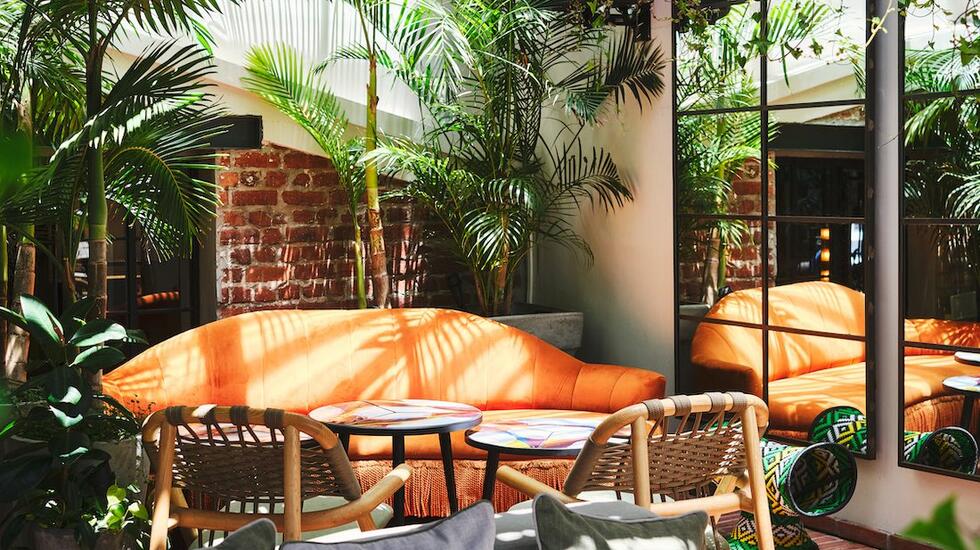
When
Tobias Alter was planning his first steps into the
hospitality business in Cape Town, he was clear what kind of hotel he wanted
to create: far from just providing a bed for out-of-towners, the
pad would offer a meeting place for Cape Town’s creative crowd. It’s the reason he chose the city’s
Central Business District (CBD) as the location, rather than the
hotel-crowded V&A Waterfront. Transforming two heritage
buildings – a stucco-covered art deco edifice and an older
Edwardian beast – into an edgy, independent stay, he persevered
with a vision for a property that would be as comfortable throwing
a party as it was offering shelter.
Our two rand? He’s succeeded. This sultry city stay felt
distinct from any other Cape Town stays we’ve tried. Doing away
with the bellboy service that’s so common in the city, Gorgeous
George offers a Soho House-esque experience (without the
membership). The hub here isn’t the lobby, but the rooftop
restaurant, bar and pool. The rooms? Just a bonus. Couple all that
with a slick design style that marries the hotel’s (and the city’s)
history with 21st-century hospitality, and we’re ready to worship
at Alter’s, um, altar.
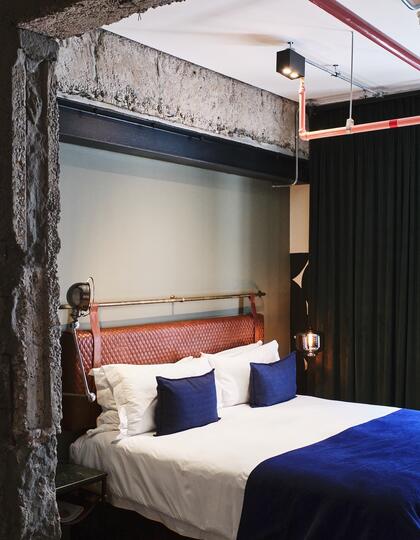
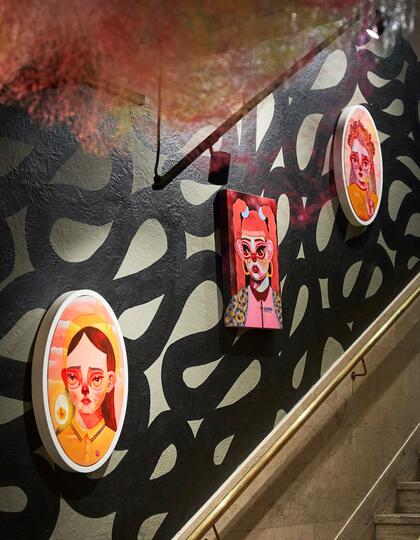
A studio bedroom, left, and local artwork in the lobby. |
Photo credit: Gibson Photo
Interiors designed by Jo’burg’s Tristan du Plessis are masculine
and moody, the tenebrosity of sculptural concrete and steel beams
lifted by a colour palette of greys, greens and burgundy. Art
lovers will be impressed; in the lobby, you’re greeted by a bronze
pig, standing sentinel beside a map of the city centre made from
1,800 hand-painted Delft tiles, an artwork by Cape Town ceramicist
Lucie de Moyencourt. The ceiling – a coiffed cloud of colourful
netting – floats above the statement carpet below. Throughout the
hotel, graphic serpentine loops by locally based multidisciplinary
artist David Brits are splashed across walls.
Hidden in a less flashy part of the city, there’s a touch of
exclusivity in Gorgeous George’s character. The urbanity; the
polish; the flair: visitors can expect a memorable stay.
All 32 industrial suites – studio, one- and two-bed – merge nods
to the city’s history with utilitarian design. Expect brass
details, acres of raw concrete, splashy artworks and a proclivity
to put books in any unused spaces. Each room has a hand-painted
wall mural from local artist David Brits, plus Delft-style tiling
behind the kitchenette area.
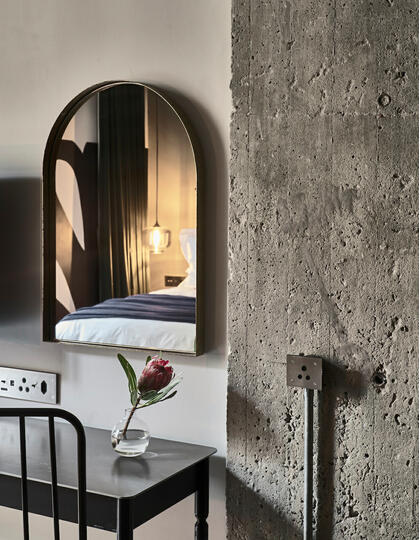
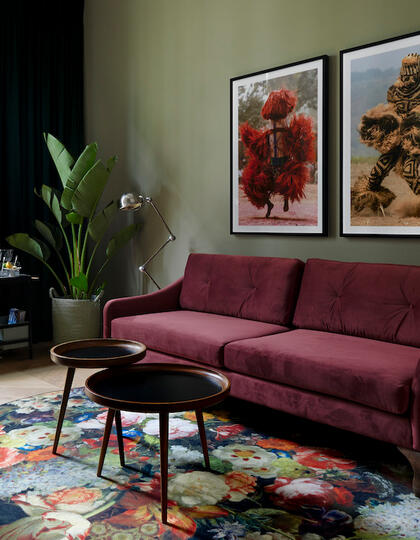
Bedrooms merge utilitarian design with nods to the city’s
history. | Photo credit: Gibson Photo
Our room had a khaki-toned feature wall, leather headboard,
graphic wall art, coloured pipework and concrete beams. The rug
took inspiration from Dutch pottery design, while shelving offered
eclectic reading suggestions: a biography of Steve Jobs, Dickens’
Great Expectations and Chaos by James Gleick. Useful, if you want
to while away a few hours reading on the luxurious burgundy velvet
sofa. Bathrooms are compact but smart, with metro-style tiling.
You’ll find a rotary-dial telephone, Marshall bluetooth speaker,
smart TV, WiFi and ghd hairdryer in each room. A Smeg kettle means
you can brew up some organic rooibos tea or, using the fresh ground
coffee provided, make a decent cup of joe in the morning (there’s a
Nespresso machine, too). The history of colonial Cape Dutch is
represented in blue-and-white ceramic tea cups. A drinks cabinet
offers sweet treats and beef biltong (for a price), plus a
selection of South African tipples.
Head upstairs to Gigi restaurant, on the houseplant-hung,
jungle-like covered rooftop. Breakfasts are big, bold and sassy.
Opt for a camping-style fry-up (boerewors sausage, bacon, tomato,
buckwheat, mushrooms and eggs) or piled-high toast offerings. Our
avocado and eggs arrived loaded on sourdough from a local bakery,
with a field’s worth of salad precariously mounted on top. If
you’re not one for coffee, try the hot chocolate, a Cape
Dutch-style dark and devilish cocoa.
Also up on the roof (perfect if you’re peckish after a dip in
the pool). The menu swings from Asian-influenced to Mediterranean
flavours, but it’s all veg-packed and vibrant. Start with a small
plate of line-caught game fish tartare, followed by a big plate of
Saldanha Bay mussels, served Thai-style, with coconut, lime, chilli
and lemongrass.
Yes. Jump out the lift at Gigi’s and you’ll find it just before
you head outside. The spaces up here all slickly interlink, but
each has a distinctive feel. In the bar, heavy wooden shelving,
Moroccan-influenced cushions, mismatched furnishings and curios
aplenty add a studious vibe.
The hotel is compact, but on the roof (again), you’ll find a
deceptive plunge pool that extends under roofing into a jungle
mural-painted room (another by David Brits). Slick sun loungers
crowd the pool. There’s no gym, but you can get a pass to Ignite
Fitness, next door.
Pretty standard. Large-size toiletries in rooms, green cleaning
products used where possible, and a sustainable, ethically sourced
menu in the restaurant (including exclusively line-caught
fish).
The hotel is accessed via a flight of steps, so it’s probably
not suitable for wheelchair users.
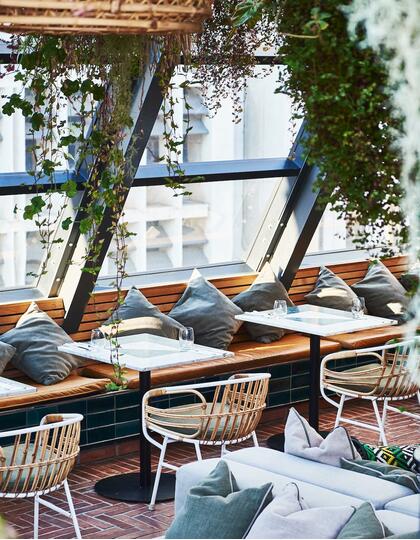
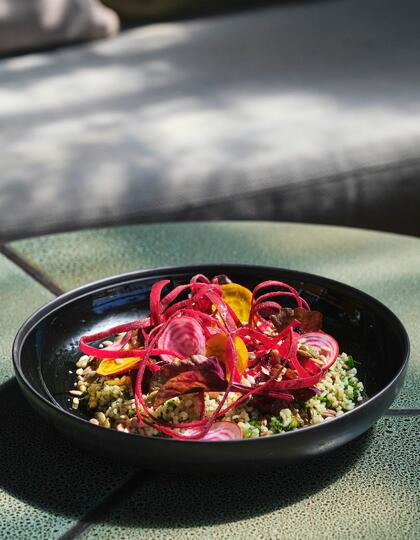
Rooftop dining at Gigi’s, left, where the menu is vibrant
and veg-packed. | Photo credit: Gibson Photo
Cape Town’s creatives have made the rooftop their home – and
out-of-towners are predominantly savvy travellers looking for a
taste of the city beyond the V&A Waterfront.
Hold up – walking isn’t really a thing in Cape Town (unless you
count jogging the Sea Point promenade). This is an Uber-obsessed
city – most of what you want is a short drive away.
Having said that, the CBD itself is walkable. Take a stroll to
find the artisanal, bean-to-bar Honest
Chocolate (the café is dreamy), hand-crafted sunglasses company
Ballo
(eyewear made from upcycled materials by a team pushing for
positive social change) and The Athletic Club & Social, a classy
cocktail spot around the corner.
The ultra-Instagrammable Bo-Kaap neighbourhood is also 10
minutes’ walk away. Tensions between tourists and residents have
been charged by increases in property taxes and gentrification
issues recently, so we’d keep your phone in your pocket and instead
head to Monkeybiz, a non-profit dedicated to reviving
traditional African beadwork.
The hotel is located on St George’s Mall, a pedestrianised
street, so if you’re arriving by car, you’ll have to walk 40m to
the front door. The CBD is pretty safe, but the area can still feel
a touch dicey late at night.
This article contains affiliate links, which means SUITCASE
may earn a small commission if you click through and book.
